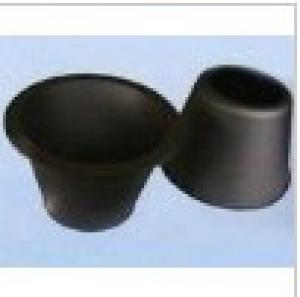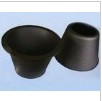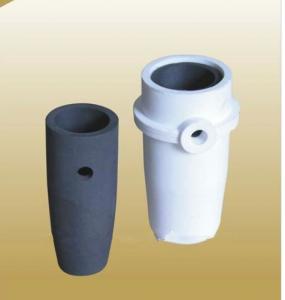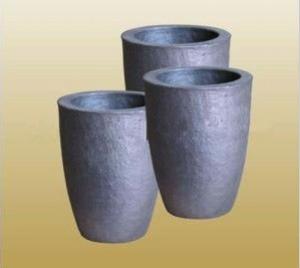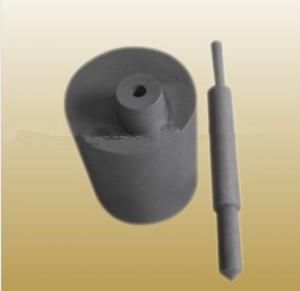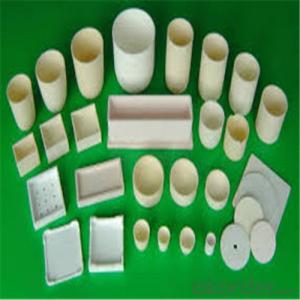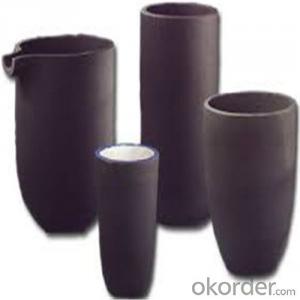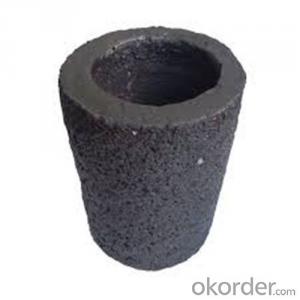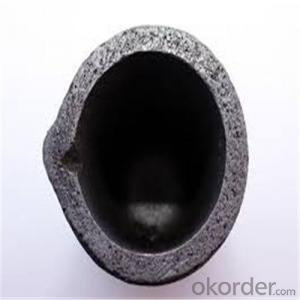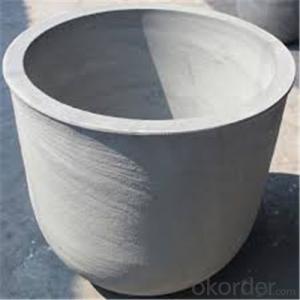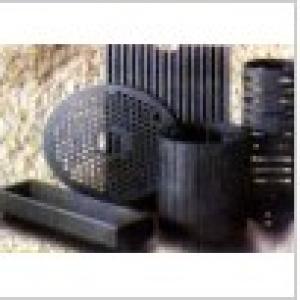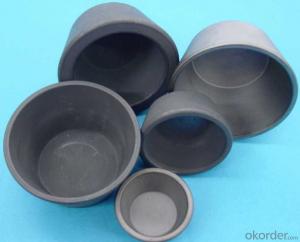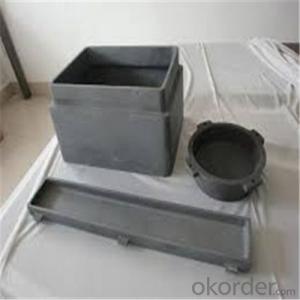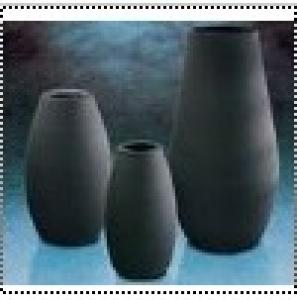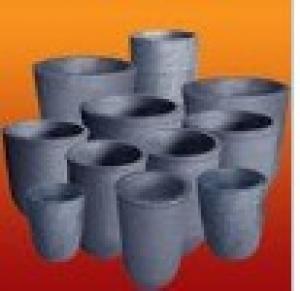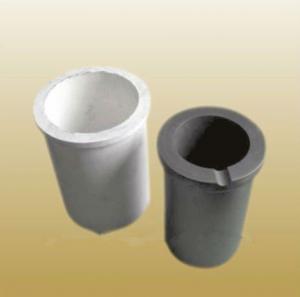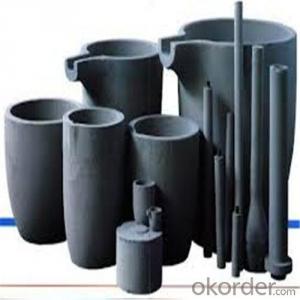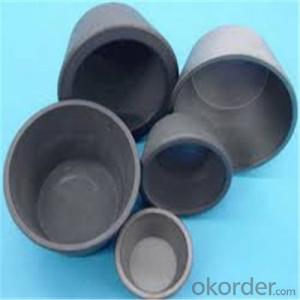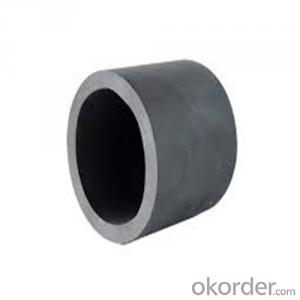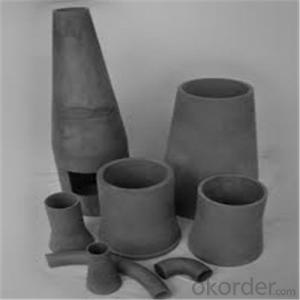10kg Graphite Crucible - High Quality Graphite Products
- Loading Port:
- China Main Port
- Payment Terms:
- TT or LC
- Min Order Qty:
- 50 Sets set
- Supply Capability:
- 5000 Sets per Month set/month
OKorder Service Pledge
OKorder Financial Service
You Might Also Like
Detailed Product Description
high purity graphite block, has good mechanical and chemical behaviours
High Purity Graphite is suitable for the graphite( anode, inner grid, outside grid,reverberation pole, and excitation) which is applied in all kinds of small size silver rectifier, and for the graphite(anode, grid) which is appplied in electronics tubes. It is used in monocrystal furnace as grapite heater, heating preservation cover,crucibles etc. The specification that our company mainly produces is as follows: Dia.40mm---275mm; height 100---150 and 2*120, 200*200, 200*320(Cube); Thickness 50---12. The special request can be customized.
- Q: How is a graphite crucible manufactured?
- A graphite crucible is typically manufactured using a process called isostatic pressing. Isostatic pressing involves placing graphite powder into a mold and subjecting it to high pressure from all directions. This process ensures that the graphite particles are evenly compacted, resulting in a dense and homogeneous crucible. The first step in manufacturing a graphite crucible is to select the appropriate graphite material. High-quality graphite with a low ash content is typically chosen for its excellent thermal conductivity, high temperature resistance, and chemical stability. The graphite is then milled into a fine powder to ensure a consistent particle size. Next, the graphite powder is poured into a flexible rubber mold. The rubber mold is designed to withstand the high pressure that will be applied during the isostatic pressing process. The mold is carefully sealed to prevent any leakage of graphite powder. The sealed mold is then placed into a high-pressure vessel. Hydraulic pressure is applied from all directions, exerting uniform pressure on the graphite powder. This pressure compacts the graphite particles, eliminating any voids or porosity that may be present. The high pressure also helps to align the graphite particles, resulting in improved mechanical properties. Once the pressing process is complete, the mold is removed, leaving behind a green crucible. The green crucible is then subjected to a baking process called carbonization. During carbonization, the crucible is heated to temperatures of around 3000 degrees Celsius in an inert atmosphere. This process removes any volatile materials and further strengthens the crucible. After carbonization, the crucible undergoes a final machining process to achieve the desired dimensions and smooth surface finish. This may involve precision grinding, turning, or milling to ensure the crucible meets the required specifications. In conclusion, a graphite crucible is manufactured through a process called isostatic pressing, which involves compacting graphite powder under high pressure. This process, along with subsequent carbonization and machining, ensures the crucible has excellent thermal conductivity, high temperature resistance, and chemical stability.
- Q: What is the purpose of using a graphite crucible?
- The primary function of a graphite crucible is to contain and endure high temperatures in diverse industrial procedures. Graphite possesses exceptional refractory properties, which means it can withstand intense heat without easily melting or reacting with surrounding materials. This makes graphite crucibles highly suitable for tasks involving metal melting, casting, and purification. Graphite crucibles find widespread usage in foundries, laboratories, and manufacturing facilities that require temperatures surpassing the melting point of most metals. The crucible serves as a vessel for the molten metal, preventing its escape and ensuring precise control over the melting process. Moreover, graphite crucibles exhibit outstanding thermal conductivity, enabling efficient heat transfer to the substance being melted. This facilitates uniform heating and consistent melting, resulting in the production of high-quality end products. Additionally, graphite's high thermal shock resistance allows for rapid heating and cooling cycles without causing any harm to the crucible. Graphite crucibles are also chemically inert, meaning they do not react with the majority of substances. This renders them suitable for handling various corrosive materials or compounds that have the potential to react with other materials. The inert nature of graphite guarantees the preservation of the purity and integrity of the materials being processed. In conclusion, the purpose of employing a graphite crucible is to provide a long-lasting, heat-resistant, and chemically inert container for high-temperature operations such as melting, casting, and purification. The ability of graphite crucibles to endure extreme heat, exhibit excellent thermal conductivity, and remain chemically inert makes them indispensable tools in a wide array of industrial applications.
- Q: What material can be used to build a furnace for intermediate frequency melting of aluminium bronze?
- Melting copper bronze can be generally used graphite crucible, more expensive, can also be used in conjunction with quartz sand, tying their own knot, drying after use.
- Q: Can graphite crucibles be used for carbonization processes?
- Yes, graphite crucibles can be used for carbonization processes. Graphite is an excellent material for high-temperature applications due to its superior thermal conductivity and resistance to thermal shock. In carbonization processes, where carbon-rich materials are heated to high temperatures in the absence of oxygen, graphite crucibles are commonly used to contain and heat the materials. The high thermal conductivity of graphite ensures efficient heat transfer, enabling uniform heating and minimizing heat loss. Additionally, graphite's resistance to thermal shock allows it to withstand rapid temperature changes during the carbonization process. Overall, graphite crucibles are a reliable and suitable choice for carbonization processes.
- Q: Can graphite crucibles be used for crystal growth?
- Yes, graphite crucibles can be used for crystal growth. Graphite crucibles are known for their high melting point, chemical resistance, and low reactivity with most substances. These properties make them suitable for creating an environment conducive to crystal growth by maintaining stable temperatures and protecting the crystals from contamination. Additionally, graphite crucibles are often preferred for their durability and ability to withstand thermal shock, making them a popular choice for crystal growth applications.
- Q: What can replace a graphite crucible?
- Silicon carbide crucibles can be used instead of graphite crucibles.
- Q: What are the advantages of using a graphite crucible over other materials?
- There are several advantages of using a graphite crucible over other materials. Firstly, graphite has a high melting point, which makes it ideal for containing and withstanding high temperatures. This characteristic allows for the crucible to be used in various applications such as metal casting, melting, and alloying processes. Secondly, graphite has excellent thermal conductivity. This means that heat is evenly distributed throughout the crucible, ensuring consistent and efficient melting or heating of the materials inside. This property also reduces the risk of thermal shock, which can cause damage to the crucible and lead to contamination of the material being processed. Additionally, graphite crucibles have exceptional chemical resistance. They are highly resistant to corrosion and do not react with most metals or chemicals, ensuring that the integrity of the material being processed is maintained. This is particularly important in the field of metallurgy, where the crucible must withstand exposure to various molten metals and alloys. Graphite crucibles also have a longer lifespan compared to other materials. They are highly durable and can withstand repeated use and exposure to high temperatures without significant degradation. This longevity reduces the need for frequent replacements, making them a cost-effective option in the long run. Furthermore, graphite crucibles are lightweight and easy to handle. This makes them convenient for use in both industrial and laboratory settings, where frequent handling and transportation may be required. Lastly, graphite crucibles offer excellent thermal shock resistance. They can withstand rapid temperature changes without cracking or breaking, ensuring the stability and safety of the processing environment. In summary, the advantages of using a graphite crucible over other materials include high melting point, excellent thermal conductivity, chemical resistance, long lifespan, lightweight design, and thermal shock resistance. These properties make graphite crucibles a preferred choice in various industries where high-temperature processing and chemical compatibility are essential.
- Q: Can a graphite crucible be used for zinc melting?
- Yes, a graphite crucible can be used for zinc melting. Graphite crucibles are known for their high melting point and excellent thermal conductivity, making them suitable for melting metals such as zinc. Graphite crucibles can withstand the high temperatures required for zinc melting without reacting or contaminating the metal. Additionally, graphite crucibles have good resistance to thermal shock, allowing them to withstand rapid temperature changes during the melting process. It is important, however, to properly clean and prepare the graphite crucible before use to ensure the purity of the melted zinc.
- Q: How does the thermal stability of graphite affect the performance of a crucible?
- The thermal stability of graphite greatly affects the performance of a crucible. Graphite is known for its high melting point and excellent resistance to thermal shock, making it a suitable material for crucibles. Its ability to withstand high temperatures without deforming or cracking ensures that the crucible maintains its shape and integrity during the intense heat of various industrial processes such as melting metals or glass. Additionally, graphite's thermal stability helps in evenly distributing heat within the crucible, allowing for efficient and consistent heat transfer. Overall, the thermal stability of graphite plays a crucial role in ensuring the durability and performance of a crucible in extreme temperature conditions.
- Q: Which is a good quality graphite crucible?
- Because the bottom of the pot is very small, it usually needs to be placed on the clay triangle to heat it directly. The crucible can be placed on the iron tripod with either positive or oblique directions, and can be placed on the basis of the requirements of the experiment. When the crucible is heated, it cannot be immediately placed on a cold metal table to prevent it from breaking due to rapid cooling. It should not be placed on the wooden table immediately so as not to spoil the table or cause fire. The correct method is to cool the metal on the tripod or to let it cool slowly on the asbestos net. For crucible purposes, see the crucible tongs. The relevant information from the supply of silicon carbide crucible dachengxian Tianjin high silicon carbide crucible crucible factory released using the latest international technology of isostatic pressing method and strict quality assurance inspection system, selection of high quality refractory raw materials, high-tech to develop a new generation of high quality silicon carbide crucible, this product has a large volume density, high temperature resistance, fast heat, acid and alkali resistance, high temperature strength, oxidation resistance and high service life is 3 times that of the clay graphite crucible.
1. Manufacturer Overview
| Location | Inner Mongolia,China (Mainland) |
| Year Established | 2006 |
| Annual Output Value | US$2.5 Million - US$5 Million |
| Main Markets | 7.14% North America 7.14% South America 7.14% Eastern Europe 7.14% Southeast Asia 7.14% Africa 7.14% Oceania 7.14% Mid East 7.14% Eastern Asia 7.14% Western Europe 7.14% Central America 7.14% Northern Europe 7.14% Southern Europe 7.14% South Asia 7.14% Domestic Market |
| Company Certifications |
2. Manufacturer Certificates
| a) Certification Name | |
| Range | |
| Reference | |
| Validity Period |
3. Manufacturer Capability
| a) Trade Capacity | |
| Nearest Port | Xingang,Tianjin |
| Export Percentage | 31% - 40% |
| No.of Employees in Trade Department | 21-50 People |
| Language Spoken: | English, Chinese |
| b) Factory Information | |
| Factory Size: | 1,000-3,000 square meters |
| No. of Production Lines | 7 |
| Contract Manufacturing | 1,000-3,000 square meters |
| Product Price Range | Low and/or Average |
Send your message to us
10kg Graphite Crucible - High Quality Graphite Products
- Loading Port:
- China Main Port
- Payment Terms:
- TT or LC
- Min Order Qty:
- 50 Sets set
- Supply Capability:
- 5000 Sets per Month set/month
OKorder Service Pledge
OKorder Financial Service
Similar products
Hot products
Hot Searches
Related keywords
